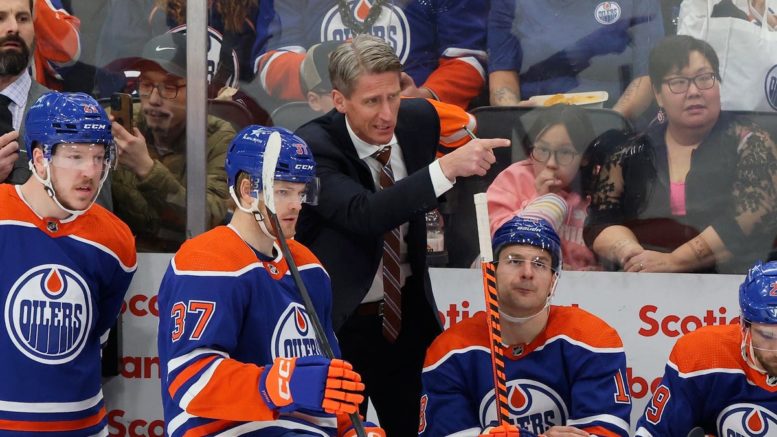That dull roar you hear in the distance would be the momentum of the Edmonton Oilers. They’re kind of out there, admittedly, which is why your house isn’t shaking. Only so much a team can do from the hinterlands of Alberta.
Anyway, the Oilers have won eight in a row and 10 of their last 13 since canning Jay Woodcroft behind the bench and replacing him with Kris Knoblauch on November 13. After slumming it with the Sharks and Hawks of the world, trying to find any accidentally discarded winning ticket on the racetrack floor, the Oilers are suddenly sitting one point off the wild-card spots in the West with games in hand on both the Coyotes and Predators. Sure, they’re nine points off the last automatic spot in the Pacific, and that might still prove to be a bridge too far for the rest of the season. But while we mock recent Oilers playoff history, any division winner wouldn’t exactly be beaming about having to deal with McDavid and Draisaitl in the first round come April.
So clearly Knoblauch has come in and wildly changed how the Oilers play, banned ketchup from the team cafeteria, and has them reading Eastern philosophy after the morning skate, right? Woodcroft was always the problem, right?
Well, no.
In hockey, where systems lean more to suggestion than rigid orders, and are still hard to implement in the middle of a season, coaching changes generally are about just changing moods or putting players on notice. But sometimes, whether there’s a connection or not, sometimes, most times even, they’re just about watching more pucks go in one net and less pucks go in the other net and then crediting the new coach with “really getting the room.” Which is all that seems to be happening in EdMo.
Has anything fundamentally changed? Not team-wide, no (all stats from NaturalStatTrick.com). Before Woodcroft’s firing, the Oilers ranked third in team Corsi-percentage and first in expected-goals percentage. Since Knoblauch took over they rank fifth and second. The Oilers were dominating play before the coaching change, they just couldn’t buy a goal or a save.
So while there really hasn’t been a structural change, there’s been a luck change. Well, that’s not totally fair. It’s not all luck. Making the decision to banish Jack Campbell to the Narnia suburbs is a move the Oilers actually made. It has seen their save-percentage at even-strength jump from .890 to .908. And .908 isn’t even all that good, as it still ranks 22nd in that timeframe. But it’s better than second-to-last, which is the goaltending the Oilers got in the first 14 games of the season (only the Flames were worse, somehow making Alberta weirder than it already was).
Another benefit that Knoblauch has gotten is that his power play can’t really miss since he got behind the bench. It’s shooting 22 percent in his stint, while hardly creating that many more chances than it was under Woodcroft’s direction (10.37 xG/60 minutes of PP time under Knoblauch vs. 9.60 under Woodcroft). It shot 15 percent while under the previous coach.
Knoblauch was brought in partly because he was Connor McDavid’s coach in juniors, and hey, maybe McDavid isn’t quite as on edge as he was earlier in the season. Or maybe he’s just shooting nearly 20 percent instead of six percent as he was earlier in the season simply because of market correction, and Knoblauch gets to soak in the added goals. However, one noticeable difference is that McDavid is producing double the individual expected goals, i.e. quality of his scoring chances, than he was under Woodcroft. Is that due simply to having Ryan Nugent-Hopkins moved back ot his wing and Draisaitl back to No. 2 center? Could be. Or it could be McDavid merely returning to his normal career averages.
The biggest difference for the Oilers since the change behind the bench is that they’re simply shooting better. In the before times, they were barely potting six percent of their shots at even-strength. That number has jumped to nine since, with little to no increase in chances. Which means that they started the year scoring 22 goals at even-strength in 13 games, and then that flipped to 32 in 13.
This isn’t all to say that the coaching change is merely window dressing. Perhaps just a change in mood gets guys to stop squeezing their sticks so much as the pressure mounts and the playoffs slip farther into the distance. Maybe Knoblauch has found a way to get guys more loose. Maybe he has a secret elixir that gets them to pick the corners a little better.
Or maybe the Oilers were always a good team that was being undone by a goalie who had most of his internal wiring ripped out and just went through a stretch of abhorrent shooting accuracy that all teams go through at some point in a season. Theirs might have just been longer and funnier. Maybe they would always come correct.
Either way, they’re more back where they always should have been, for whatever reason.
Follow Sam on Twitter @Felsgate and on Bluesky @Felsgate.bsky.social
Original source here
#Edmonton #showing #coaching #change #means





